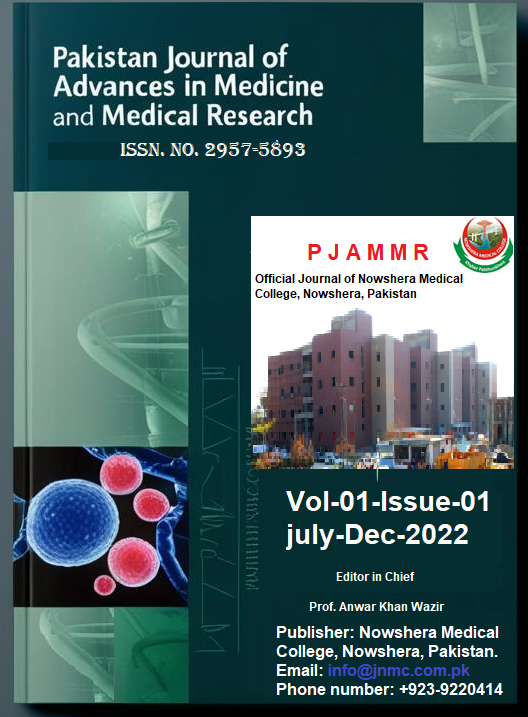Introducing WHO-Recommended Trauma Documentation Form To Enhance Trauma Management And Improve Patient Outcomes.
Quality improvement project
DOI:
https://doi.org/10.69837/pjammr.v1i01.50Abstract
Background: This Quality Improvement Project (QIP) aims to evaluate and enhance the documentation process for trauma patients presenting to the Surgical Trauma Department at Combined Military Hospital (CMH) Abbottabad. Proper documentation is critical for ensuring continuity of care, optimizing patient management, and maintaining medico-legal accuracy. This audit will assess the existing documentation practices against standardized guidelines and introduce the WHO Standardized Emergency Unit Form to streamline record-keeping and improve data accuracy. The project was conducted over a six-week period, from February 1 to March 10, 2022, with the goal of identifying deficiencies, implementing corrective measures, and ultimately improving compliance with standardized documentation protocols.
Aim and Objectives :This Quality Improvement Project (QIP) aims to evaluate and enhance the documentation process for trauma patients presenting to the Surgical Trauma Department at Combined Military Hospital (CMH) Abbottabad. Proper documentation is critical for ensuring continuity of care, optimizing patient management, and maintaining medico-legal accuracy. This audit will assess the existing documentation practices against standardized guidelines and introduce the WHO Standardized Emergency Unit Form to streamline record-keeping and improve data accuracy. The project was conducted over a six-week period, from February 1 to March 10, 2022, with the goal of identifying deficiencies, implementing corrective measures, and ultimately improving compliance with standardized documentation protocols.
Methodology: This audit was conducted to evaluate and improve the documentation process for trauma patients at CMH Abbottabad. Initially, a thorough review of the existing documentation practices was carried out, revealing the absence of a standardized documentation form. To assess the impact of structured documentation, feedback was collected from healthcare providers regarding the current practice. Subsequently, the WHO Standardized Emergency Unit Form: Trauma was introduced on a trial basis in one surgical unit. Training sessions were conducted to familiarize the medical staff with its proper use, ensuring compliance and efficiency in documentation. Following successful implementation in the pilot unit, the form was progressively introduced across all surgical units. Key performance indicators—including complication rates, in-hospital mortality, duration of hospital stay, and the mean time to initial assessment—were analyzed using hospital records to compare outcomes before and after the implementation of the standardized form.
Results: The primary outcome measure was case coverage, defined as the percentage of trauma cases documented using the standardized form each week. In the first audit cycle, compliance started at 30% in the initial week but improved to 66% after targeted interventions. The second cycle demonstrated a significant improvement, with coverage consistently ranging between 83% and 90%. However, during the third cycle, documentation rates initially dropped to 52% due to doctor strikes and the induction of a new batch of foundation year trainees. This decline was short-lived, as focused training efforts helped restore compliance to 77% in the following week.
In addition to improved documentation rates, there was a notable reduction in the mean time to initial assessment, which decreased by 30%, from 38 ± 6.2 minutes to 26 ± 4.8 minutes (p = 0.023), reflecting enhanced efficiency in patient evaluation and management. These findings underscore the positive impact of implementing a standardized trauma documentation system on both workflow efficiency and patient care.
Conclusion: Effective medical documentation is fundamental to ensuring seamless patient care, medico-legal accountability, and interdisciplinary communication. The introduction of the WHO Standardized Emergency Unit Form: Trauma at CMH Abbottabad significantly improved documentation practices, providing a structured and systematic approach to trauma patient management. This not only enhanced communication among healthcare providers but also contributed to more efficient decision-making and improved patient outcomes. By standardizing documentation, the initiative reinforced consistency, accuracy, and quality of care, ultimately strengthening the overall trauma management system.
Keywords: Audit, medical documentation, trauma care, quality improvement, implementation, WHO Standardized Emergency Unit Form, patient safety.
Downloads
Published
How to Cite
Issue
Section
License
Copyright (c) 2022 Muhammad Awais Jamil, Tahir Nawaz, Maria Saleem, Muhammad Abbas Khan

This work is licensed under a Creative Commons Attribution-NonCommercial 4.0 International License.






